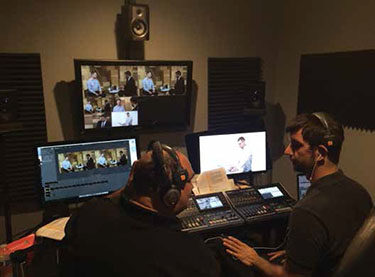There are many variables to consider when choosing a presentation switcher for specific uses, spaces and expectations. Below are some tips from industry experts to help you create a check-list of key features to look for when you compare products. In the end, the important thing is to become informed and find a technology partner who will work with you to find the right solution for user needs.
Video Sources: Of course, you need to consider the type of video sources that you will be switching to any display. “If you have a variety of video sources, video formats or are switching to LED walls or unusual sized screens be sure to purchase a switcher that has scaling on the inputs and scalers on the outputs so you can mix and match video resolutions and output to custom pixel sizes found on LED walls,” said Rob Read, Business Development Manager at Roland Professional A/V.

Aaron Booker (left), founder and CEO of Bellingham, WA-based Varvid, a full service live event media production company, uses Roland presentation switchers for large and small presentations. Recently, Booker recommended the V-1SDI, 3G-SDI Video Switcher to a higher ed client needing a small portable and budget-conscious solution. “One of the features we love about them is they support 3G SDI, so you can send a 1080p signal off to the switcher nicely. The little $1,500, Roland V-1SDI switcher is perfect for them, he said. For larger and more complex events, the Varvid team uses the VR-50HD Multi- Format AV Mixer. “We really loved that switcher because it not only has that HDMI input with scalers, but every input scales,” said Booker. “And it has VGA input so you can take old laptops, old projectors, and output VGA cable which runs a long distance, and then it just works. Just working is wonderful.”
PHOTO COURTESY OF VARVIDSignal Formats: Be sure to find out what kind of signal formats does it support such as HDMI, DisplayPort, HDBaseT, VGA, Component Video, etc., and how many inputs and outputs are included, said Joseph Barbier, marketing manager at DVIGear. “Does it include video scaling, and if so, what are the resolution limitations? It is critical to consider resolution capabilities as this varies widely by device. Which resolutions are supported on each input versus each output?”
Picture-in-Picture: When looking at a switcher that has PiP composition layers be sure to check if the PiP’s can be adjusted in size and position. “In some cases, size is not as important as positioning the PiP window to a location on the screen that doesn’t interfere with the background layer,” said Read. “Additionally, some PiP functions are useful to adjust border color and width to help enhance the PiP windows in your presentation. Some switchers are limited to one layer composition, so if you need a PiP and a lower third layer be sure to select a switcher than has two or more layers of composition.”
HD or 4K: While most video sources are still HD, if your budget allows purchasing as switcher that is 4K will help future-proof your investment. “The term ‘4K’ is a big buzzword right now, but the truth is there are many flavors of 4K resolutions being used today,” said Barbier. Common variations include: 4K /30p, 4K /60p (4:2:0), 4K /60p (4:4:4), 4K (HDR), 4K DCI (4096x2160), 4K UHD (3840x2160), and even others. These variations are suited for different purposes. For instance, 4K /60p (4:2:0) is suitable for playback of Blu-ray movies, but is not useful for as a computer monitors because text and many applications will appear very small on the screen.
“But 4K becomes useful when your video screens are LED walls and larger than a 1920 pixels wide and that you have custom content or 4K cameras to accommodate a larger video image,” Read added. “When choosing a 4K switcher be sure that it supports HDMI 2.0 as this is the only practical 4K connection to the switcher.”
Audio Considerations: “Embedding and de-embedding audio to and from a video source like HDMI and SDI is very useful for streaming or recording,” said Read. “Selecting a video switcher with built-in advanced audio functions will help to eliminate external gear to embed and de-embed audio to the video sources.”
Going the Distance: HDBaseT technology enables users to present from remote sources or to transmit to a remote display over existing CAT5e and CAT6 cable. “Presentation switchers with built-in HDBaseT extension enable users to take advantage of existing infrastructure saving both time and money,” said Gina Dickson, VP Marketing, Technology Product Solutions at Black Box.
Read agreed adding, “Some video switchers are incorporating HDBaseT in the output connectors so you can use an Ethernet cable to go directly into your screen or projector or convert from HDBaseT at the screen source to HDMI.” If you need to go long distances from your video sources or video displays, consider a switcher with SDI connections or HDBaseT connection. SDI inherently supports longer distances than HDMI.
Seamless Switching: When more than one source is required, it can be inefficient and time consuming to switch between sources. Look for the ability to switch quickly between sources, like projectors and laptops, with low latency. “Lulls in a presentation can lead to losing the audience’s interest,” said Dickson.
This is especially important for live events, such as houses of worship services, added Clint Hoffman, chief operating officer at Kramer Electronics. “What is the switching time and how ‘clean’ is that switch? This is very important. Be sure you know how quickly a switch will occur and what it might look like on screen.”
Control: Don’t forget to consider how the system will be controlled. Can the switcher be controlled via LAN, RS-232, IR, and/or front panel buttons? Look for advanced control features. “For instance, EDID management is a critical component of system management that is sometimes overlooked or misunderstood,” warned Barbier. “Does the product include powerful EDID management capabilities, just basic EDID adjustments, or even any EDID management at all?”
IMAG Considerations: “All-in-one purpose-built hardware switchers are more likely to have lower latency and are designed for live production switching which include IMAG (Image Magnification),” noted Read “Many system-dependent or computer-based switchers are designed for web streaming and are not suitable for in-room switching due to the high latency.”
Info
blackbox.com
crestron.com
cumc.columbia.edu
dvigear.com
kramerus.com
roland.com
varvid.com
